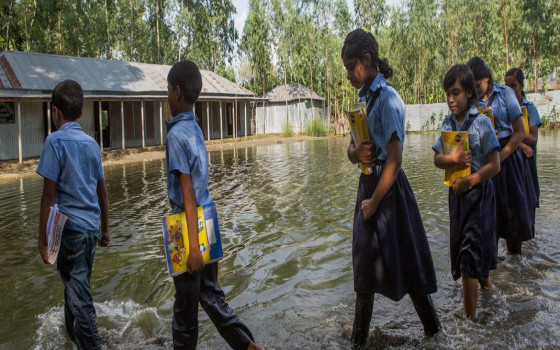
UNICEF: A difficult future awaits children in the face of climate crises, demographic shifts, and pioneering technologies

- Europe and Arabs
- Thursday , 21 November 2024 8:36 AM GMT
New York: Europe and the Arabs
Under the title "The State of the World's Children 2024: The Future of Childhood in a Changing World", a report issued by UNICEF showed that a difficult future awaits children around the world unless urgent measures are taken to protect their future. According to the United Nations daily news bulletin, a copy of which we received this morning, Thursday
The new report reveals how three major global trends will affect children's lives by 2050 and beyond. These three trends are demographic transition, climate and environmental crises, and pioneering technologies. The release of the report coincides with the celebration of World Children's Day, which is held this year under the slogan "Listen to the future. Stand up for children's rights".
Catherine Russell, Executive Director of UNICEF, said that children face countless crises from climate shocks to online risks, "and these crises are set to intensify in the coming years."
“The projections in this report show that the decisions that world leaders make today – or fail to make – shape the world that children will inherit. Creating a better future in 2050 requires more than just imagination, it requires action. Decades of progress, especially for girls, are at risk,” she added.
Climate crises and demographic shifts
According to the report, climate and environmental crises are expected to become more widespread in the decade 2050-2059, with eight times more children exposed to extreme heatwaves, three times more to severe river flooding, and nearly twice as many to severe wildfires than in 2000.
The report underscores the urgent need for targeted environmental action to protect all children and mitigate the risks they face. Sub-Saharan Africa and South Asia are expected to have the largest number of children in the 2050s.
But the report also points to projections of ageing populations, with the proportion of children expected to decline in every region of the world.
The report predicted that the number of children will fall to less than 40 percent in Africa, down from 50 percent in the first decade of the twenty-first century, and to less than 17 percent in East Asia and Western Europe.
The report explained that these demographic shifts create challenges, as some countries are under pressure to expand services for large numbers of children, while others are working to balance the needs of a growing elderly population.
Promise and danger
The UNICEF report warned that leading technologies, including artificial intelligence, represent both promise and danger for children who are already interacting with artificial intelligence embedded in apps, games, virtual assistants and learning programs.
But it also noted that the digital divide remains stark. In 2024, more than 95 percent of people in high-income countries will be connected to the internet, compared to about 26 percent in low-income countries. The report noted that a large proportion of young people in low- and middle-income countries face difficulties in accessing digital skills, which will affect their ability to use digital tools effectively and responsibly in education and the workplace of the future.
Three recommendations
The report included some good news, as life expectancy at birth is expected to increase.
It also expected that the gains in children’s access to education achieved over the past 100 years will continue, as nearly 96 percent of children worldwide are expected to receive at least primary education in the 2050s, up from 80 percent in the first decade of the 21st century.
The report called for addressing the challenges and opportunities posed by the three megatrends by investing in sustainable and resilient education, services and cities for children, expanding climate resilience in infrastructure, technology, basic services and social support systems, and providing connectivity and safe technology design for all children.












No Comments Found